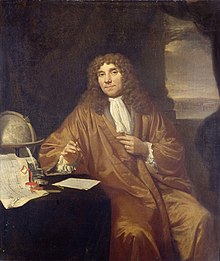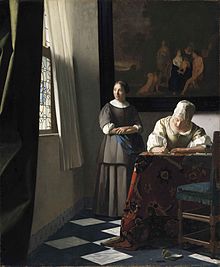The astronomer

|
| The astronomer |
|---|
| Jan Vermeer , 1668 |
| Oil on canvas |
| 51.5 x 45.3 cm |
| Louvre |
The Astronomer is an oil painting paintedby Jan Vermeer in 1668.
The small-format picture shows an astronomer in his study and, with its counterpart , the painting The Geographer from the Frankfurt Städel , occupies a special position in Vermeer's complete oeuvre , since in his complete oeuvre of around 37 surviving paintings, only these two depict a single man is.
The picture belongs to the collection of the Louvre in Paris and can be seen in the permanent exhibition.
Image description
The astronomer sits on a chair in front of his work table and looks at a celestial globe . It looks like he's trying to rotate the globe with the middle finger of his right hand, with the thumb ready to slow or stop the rotation. With his left hand he leans on his desk and pushed back the heavy carpet that covered him. On the table top lie an open book, a note sheet and - half pushed under the carpet - an astrolabe . With his striking profile, hairstyle and clothing, the still youthful-looking astronomer resembles the geographer in the picture exhibited as a counterpart in the Städel . Like him, he wears his thick brown hair parted in the middle, combed back tightly and swells in a thick wad behind his ears down to his chest. Like the geographer, he wears a wide blue cloak from under which a narrow strip of white undergarment peeks out.
Bright light falls from an artistically glazed lattice window onto the desk. The colored medallion , which is inserted into the square fields made of white glass, is cut off from the window reveal. Light only falls through one wing, the second remains closed by a wooden shutter and the window's skylight is partially covered by a curtain.
Some of the objects depicted in Vermeer's picture have been identified by art science . On the table is the writing of the Dutch mathematician and astronomer Adriaan Adriaanszoon Metius , Institutiones Astronomicae Geographicae in the second edition of 1621. The open page deals with the “divine inspiration”, which is necessary for astronomical research in addition to knowledge.
The celestial globe comes from the workshop of Jodocus Hondius , you can see the northern sky with the constellations Great Bear , Hercules , Dragon , Libra and Lyre .
The astronomer as an astrologer
The picture on the wall, The Finding of Moses , was also represented by Vermeer in The Letter Writer and Maid (around 1670). It probably belonged to the inventory of his mother-in-law's house, where he lived with his family, and which he often depicted in pictures. The picture is about the birth of a person, just as the planetary constellations on the blackboard on the cupboard, according to the understanding of astrology , are related to the birth of a person. From ancient times to the early modern times , astrology and astronomy were two aspects of astronomy, the separation of astronomy as a science was only completed later. The great astronomers of the 16th and 17th centuries, such as Copernicus , Tycho Brahe and Kepler, were also popular astrologers.
Vermeer's astronomer still conducts his studies in a closed room, the window also remains closed, the shutters and curtains darken the room. A telescope like the one used by Vermeer's contemporaries Isaac Newton or Christiaan Huygens and developed by Vermeer's contemporaries Antoni van Leeuwenhoek cannot be seen.
Dating
The picture is one of the few hand-dated and signed pictures by Vermeer's. It is signed in the door panel of the cabinet with the sea and the Roman numerals MDCLXVIII (1668). A small dark line next to the Roman five led to the assumption that it could be a Roman ten, so that it resulted in 1673 and thus possibly would have spoken against a counterpart , since the geographer is dated to 1669. The microscopic examination of this dating clarified, however, that the said line is below five and is therefore not part of this number.
Provenance
The astronomer belonged to the collection of Édouard Alphonse James de Rothschild , who inherited it in 1905 from his father Alphonse de Rothschild , who in turn had owned the painting - according to a catalog by Henry Havard - since at least 1888. In 1940, after the Nazis invaded France, the painting was confiscated by Reichsleiter Rosenberg's operational staff . After the end of World War II , the painting was returned to the Rothschilds. In 1982 it was donated to the Louvre .
Questions of marine exploration
Antoni van Leeuwenhoek or ideal type of scholar

Since the astronomer and the geographer are the only paintings by Vermeer that have a kind of portrait character, it is possible that Antoni van Leeuwenhoek served as a model for the scholarly pictures of Vermeer. Vermeer and van Leeuwenhoek must have known each other, this is supported by the fact that both men were of the same age and both families were active in the textile trade . The portrait of Jan Verkolije from 1687 shows van Leeuwenhoek at the age of 54. When Vermeer painted the astronomer and the geographer, van Leewnhoek was 30 years old, which is the age of the astronomer and the geographer. Arthur Wheelock advocates the thesis that van Leeuwenhoek is the man portrayed by the astronomer and the geographer. He sees similarities in the long hair, which in Antoni van Leeuwenhoek's case is curly like a wig, as well as in the broad forehead and the large, angular nose and the long robe with a shawl collar , which was common among scholars at the time.
But it could also be the representation of an ideal type of scholar. Since Rembrandt van Rijn and his school, this was a popular motif among the Dutch painters of the time. This type of image would therefore not be an invention of Vermeer's, and there were also models for the learned professions, geographer and astronomer. One of the best known early examples of the 17th century in Holland is Thomas de Keyser's "Portrait of Constantijn Huygens with his secretary" from 1627. It shows the influential, highly educated statesman and poet with the classic attributes of a scholar: globes , books and scrolls of parchment.
Since there is a great similarity between Antoni van Leeuwenhoek and Vermeer's scholarly images, as Arthur Wheelock has established, as well as the assumption that the two men must have known each other, since van Leeuwenhoek was even appointed as his administrator after Vermeer's death, makes it credible, that both images are portraits of the natural scientist van Leeuwenhoek. In the portrait by Jan Verkolje one can see further evidence that Antoni van Leewenhoek must have aroused the interest of the painters of the time. There is also the possibility that van Leeuwenhoek commissioned the scholarly pictures.
Astronomer and geographer - individual representations or counterparts
Both pictures have an almost identical picture structure: the protagonists look to the left, the lighting is the same, rooms and furnishings are similar: the same cupboard, a table, a chair, a carpet, pictures on the wall, a terrestrial globe and a celestial globe . However, there are subtle differences in the perspective and the degree of soffit . The pictures are not composed in mirror image, as is often the case with their counterparts , but on the other hand, with one exception, there are no known right-facing interiors of Vermeer's. The arguments in favor of a counterpart are mainly of a substantive nature. The topic, two natural scientists at work, has a clear intention, because astronomy and geography are crucial orientational sciences for a people like the Dutch who go to sea and do business and wants to develop and take possession of new areas.
The content and the same dating of the scholarly pictures speak strongly in favor of a counterpart, whereas the fact that the two canvases do not come from the same bale can be cited as an argument for individual representations.
literature
- Ben Broos, Arthur K. Wheelock (Eds.): Vermeer. The complete work. Belser, Stuttgart 1995, ISBN 3-7630-2322-4 .
- Ann Jensen Adams et al. a .: Reading desire. Dutch painting from Rembrandt to Vermeer . Hatje, Stuttgart 1993, ISBN 3-7757-0475-2 (catalog for the exhibition of the same name from September 24, 1993 to January 2, 1994).
- Katrin Leonhard: The painted room. To the interior painting by Jan Vermeer. Fink, Munich 2003, ISBN 3-7705-3876-5 .
- Michael Maek-Gérard (Ed.): Johannes Vermeer, The geographer and the astronomer reunited after 200 years. Städelsches Kunstinstitut and Städtische Galerie, Frankfurt / M. 1997 (catalog for the exhibition of the same name from May 15 to July 13, 1997).
- Stefano Peccatori, Stefano Zuffi: Jan Vermeer. DuMont, Cologne 1999, ISBN 3-7701-4546-1 (Famous painters at a glance).
- Norbert Schneider: Vermeer all paintings. Taschen, Cologne 2004, ISBN 3-8228-6377-7 .
- Arthur K. Wheelock: Vermeer. DuMont literature and art publishing house, Cologne 2003, ISBN 3-8321-7339-0 (DuMont's library of great painters).
Web links
- The astronomer on the homepage of the University of Heidelberg
- The astronomer on essentialvermeer.com
Individual evidence
- ↑ JA Welu: Vermeer's Astronomer: Observations on an open book. In: The Art Bulletin. Vol. 68, 2. 1986, pp. 263-267.
- ↑ a b c d Städelsches Kunstinstitut and Städtische Galerie: Johannes Vermeer, The geographer and the astronomer reunited after 200 years. Frankfurt am Main 1997, pp. 8-82.
- ^ Henry Havard: Van der Meer de Delft , Paris, Librairie de l'Art, (1888), p. 38
- ↑ Günther Haase: Art theft and art protection, Volume I: A Documentation , self-published by BoD, Hamburg, (2008)
- ^ Hector Feliciano: The Lost Museum: The Nazi Conspiracy to Steal the World's Greatest Works of Art . Basic Books, 1998, ISBN 0-465-04191-4 .
- ↑ Städelsches Kunstinstitut and Städtische Galerie: Johannes Vermeer, The geographer and the astronomer reunited after 200 years . Frankfurt am Main 1997, p. 8f.

